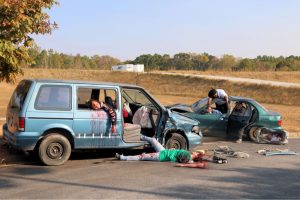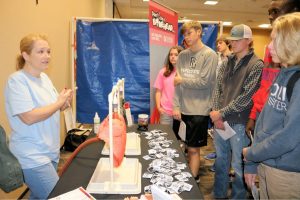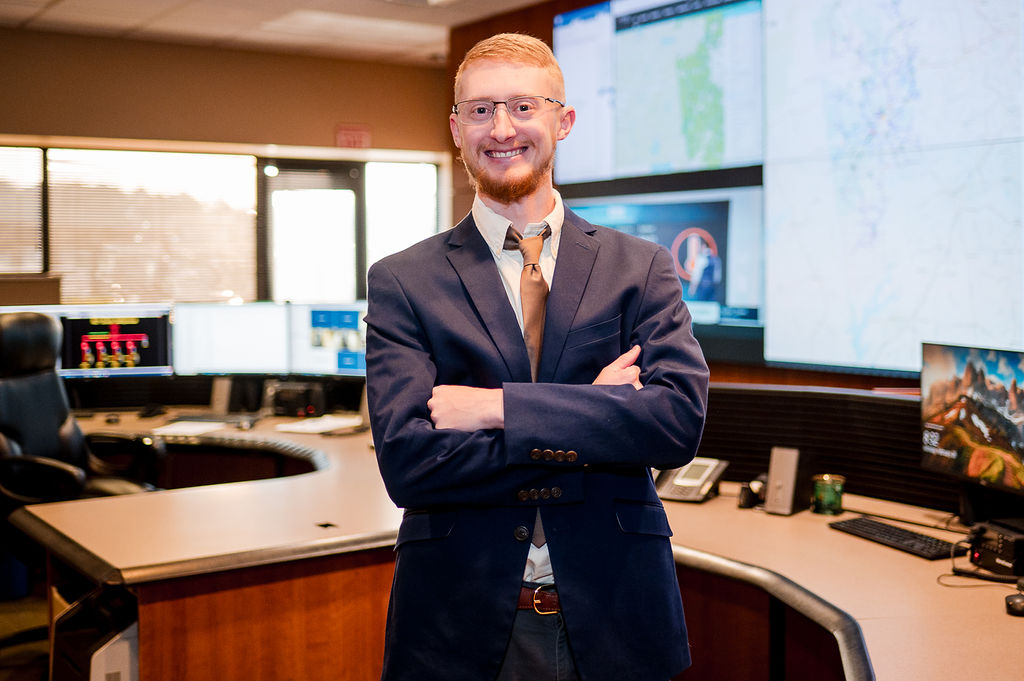
Imagine a violent two-vehicle crash. The screams and cries for help from the victims emanate from the cars. Sirens in the distance signal hope that help is coming, followed by the image of red and blue lights flashing. Law officers and firemen arrive on the scene. In the car: hurt and dying teens from the local high school.
EMS personnel arrive and begin CPR and other lifesaving interventions, but for one teen, rescuers check and move on to focus their efforts on the others. The teen is the deceased victim of a crash caused by texting or drunk driving.
This was one of the scenes portrayed during the Haralson County Teen Maze event on Nov. 10 at the West Georgia Technical College Conference Center in Waco. The scene was not real, but designed to give teens the experience of living through such a nightmare. This graphic experience is lived out throughout the teen maze, which is an interactive event that gives students an opportunity to safely explore the challenges of teenage years — and face the consequences of their actions — in a realistic simulation.
Tanner Health System’s Get Healthy, Live Well and staff at Higgins General Hospital joined other organizations in helping teenagers make better choices. The Haralson County Family Connection partnered with several organizations to host the teen maze.
During the event, teens navigated from one station to another while experiencing lifelike situations.
The maze was open to the public on Nov. 8 and Haralson County High School students went through the maze on Nov. 9. Bremen High School students toured the maze on Nov. 10.
“Teen Maze promotes awareness and urges the students to think about potential consequences of risky behavior and decisions based on various situations,” said Jennifer Dobbs, executive director of Haralson County Family Connection.” As a community, we are trying to help teens in a proven and unique way.”
The maze explored the consequences of texting while driving, substance abuse and early sexual involvement. Higgins General Hospital staff participated in a scene where students observed doctors and nurses treat a trauma patient who suffered severe injuries that led to a cardiac arrest.
“Higgins volunteered to coordinate the trauma room scene and we created a scenario to show the students what it’s like for a patient to be seen in the emergency department after a traumatic car accident,” said Allison Daniel, RN, a registered nurse at Higgins General Hospital.
Get Healthy, Live Well organized the part of the maze that explored the consequences of using tobacco — from yellow teeth to lung and oral cancers.
“Being able to show teens the short-term and long-term effects of tobacco will go a long way in helping them make better choices,” Phyllis Head, community liaison at Get Healthy, Live Well. “Events like these give the community an opportunity to come together and make a huge impact on teen’s lives.
Nursing students from the University of West Georgia and WGTC joined Get Healthy, Live Well staff members in helping the event run smoothly.
UWG nursing student Dana Hammack participated in the Higgins General Hospital trauma room scene involving a crash victim. Hammack is part of a preceptorship program that helps nursing students increase knowledge and gain sills in community health work. Get Healthy, Live Well and the UWG’s Tanner Health System School of Nursing partnered to create the program, which connects students to a variety of community health opportunities in Carroll, Haralson and Heard counties.

“I really think it’s important to get out there and know your community,” said Hammack who wants to be an emergency room nurse when she graduates.
WGTC nursing student Brandi Hambrick, who is interested in holistic or community-based nursing, agrees.
“I think it’s really important to be able to connect to the community that you serve — actually understanding what’s going on, not just having a set script that you give,” said Hambrick. “If your community has a high rate of teen pregnancy, you need to be able to address teens in a way that they’re going to receive that.”
Volunteering at the funeral station gave her an opportunity to see what teens were thinking and how the messages they received that day affected them. Teens whose choices led them to their own funeral must write a eulogy.
“They have to go there, write their eulogy and be exposed to what their family or friends would feel like if they lost them today as a result of teenage drinking, tobacco use or something else that might put their lives in peril,” said Hambrick. “I think that’s really sobering for a teenager.”
For more information, contact Jennifer Dobbs, coordinator of the Haralson Family Connection Coalition, at 770.328.1736 or [email protected]. For more information about Get Healthy, Live Well, visit www.GetHealthyLiveWell.org.





